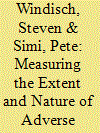| Srl | Item |
| 1 |
ID:
188074


|
|
|
|
|
| Summary/Abstract |
While progress has been made to understand mid-life correlates associated with extremist participation, much less research focuses on adolescent risk factors. The purpose of the current study is to expand upon the focus on individual-level correlates by assessing the extent and nature of childhood adversity among a sample of former white supremacists. The current study relies on in-depth life-history interviews with ninety-one North America-based former white supremacists and the Adverse Childhood Experiences questionnaire. Overall, the current sample contained elevated rates of childhood risk factors with 63 percent of participants having experienced four or more adverse experiences during the first eighteen years of their lives (as compared to 55 percent of a comparison “high risk” sample and 16 percent of the U.S. general population sample). Furthermore, participants discussed a variety of maladaptive coping strategies associated with adversity that generated vulnerabilities to adolescent misconduct and extremism early in the life-course. Our findings indicate that extremist onset does not begin with a single life event but rather is generated, and further exacerbated by the cumulative impact of multiple adverse experiences during childhood.
|
|
|
|
|
|
|
|
|
|
|
|
|
|
|
|
| 2 |
ID:
165313


|
|
|
|
|
| Summary/Abstract |
In order to move beyond the existing push/pull framework to understand disengagement, we apply a systematic coding scheme derived from Mayer and colleagues' integrative model of organizational trust to examine why people leave extremist groups. In doing so, we also rely on in-depth life history interviews with twenty former left- and right-wing extremists to examine whether antecedents of distrust vary between the two groups. Findings suggest substantial similarities and important differences between left- and right-wing extremists' decision to leave. In particular, perceptions of poor planning and organization, low-quality personnel and vindictive behavior generate perceptions of organizational distrust and disillusionment. Although findings from the current study are based on a relatively small sample, notable similarities were identified between both groups regarding sources of distrust (e.g., leaders, group members). We also identified differences regarding the role of violence in weakening solidarity and nurturing disillusionment with extremist activities. We conclude this article with suggestions for future research that extend the study of terrorism and that may have significance for how practitioners address countering violent extremism initiatives.
|
|
|
|
|
|
|
|
|
|
|
|
|
|
|
|
| 3 |
ID:
172202


|
|
|
|
|
| Summary/Abstract |
Few issues have garnered as much attention in recent years as the topic of violent extremism (VE). Although substantial attention has been devoted to investigating the radicalization process, few scholars have examined the obstacles that hinder VE radicalization. Based on in-depth life history interviews, the current study examines five types of barriers that hinder radicalization toward mass casualty violence (MCV): mass casualty violence as counter-productive; preference toward interpersonal violence, changes in focus and availability; internal organizational conflict; and moral apprehension. In general, we address each barrier’s unique contribution to hindering the likelihood of MCV. Finally, we discuss how our findings could be used as part of initiatives aimed at countering violent extremism (CVE).
|
|
|
|
|
|
|
|
|
|
|
|
|
|
|
|